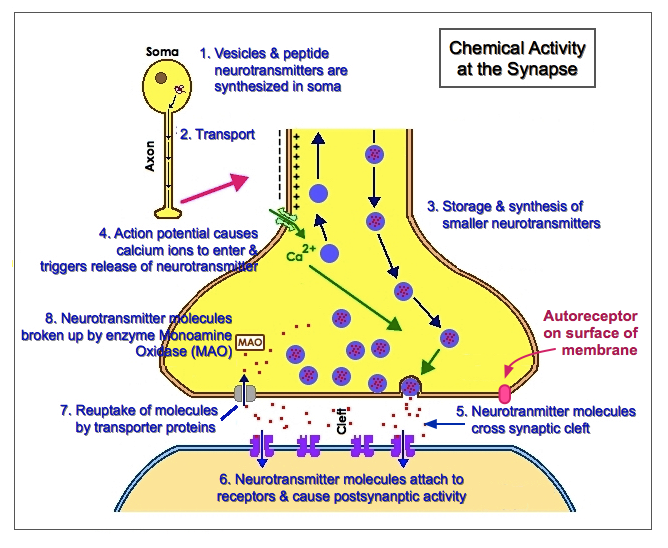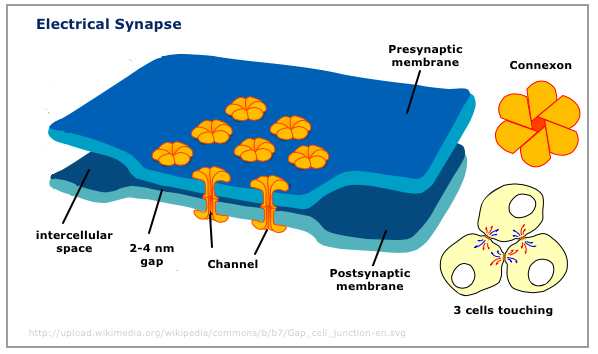![[head]](../graphics/head.gif)
PSY 340 Brain and Behavior
Class 08: Chemical Events at the Synapse [Outline]
|
|
PSY 340 Brain and Behavior Class 08: Chemical Events at the Synapse [Outline] |
|


A. Types of Neurotransmitters
- More than 100 neurotransmitters have been identified or suspected
- Many neurons release 2, 3, or more neurotransmitters in the same combination along all branches of the axon
Type Neurotransmitters Some Important (but not all) Functions & Facts Amino Acids Glutamate (Glu) excitatory
GABA (Gamma-aminobutyric acid) inhibitory
Modified Amino Acid Acetylcholine (ACh)
Monoamines Indoleamine • derived from tryptophan (an amino acid from diet)
Serotonin (5-HT or 5-hydroxytryptamine) modulation of emotion
Catecholamines • derived from phenylalanine (an amino acid from diet) Tyrosine
Dopa
DA/NE/Epinephrine (see below)
Dopamine (DA) Muscle coordination
Reinforcement
Creates salience/urgency/captures attention
Norepinephrine (NE) modulation of emotion Epinephrine (Adrenaline) stimulates sympathetic nervous system
Other Peptides
(> 100 different types)
Endorphins (& enkephalins) • suppresses transmission of pain by hyperpolarizing neurons which send out Substance P
Substance P dull chronic pain (e.g., cancer, nerve tissue damage)
Neuropeptide Y stimulates feeding and fat storage
Purines Adenosine, ATP,
et al.Adenosine => signals onset of sleep
ATP => basic energy in cell
Gases NO (Nitric Oxide) dilates blood vessels; created as needed
Sources: Kalat (2005, 2007, 2009. 2016), Kimball (2005)
B. Transport & Storage of Neurotransmitter/Release and Diffusion of Neurotransmitters
- synaptic vesicles
- exocytosis.
C. Receptor Activation on the Postsynaptic Cell
1. Ionotropic
- Depolarization (EPSP): Glutamate
- Hyperpolarization (IPSP): GABA
2. Metabotropic & Second Messenger Systems
Neuropeptides (endorphins, substance P, neuropeptide Y, etc.) = neuromodulators
Variations in Receptors
Drugs Binding to Receptors
- Nicotine stimulates a family of acetylcholine receptors call nicotinic receptors.
- Opiate drugs (heroin, morphine, etc.) bind to the same receptors as the brain's endogenous morphines (i.e., endorphins)
D. Inactivation and Reuptake of Neurotransmitters
- Reuptake
- Serotonin molecules experience reuptake. Prozac and other SSRI (selective serotonin reuptake inhibitor)
- methylphenidate (Ritalin), a mild stimulant used for persons with attention deficit hyperactivity disorder (ADHD), as well as cocaine block the reuptake of dopamine.
- Inactivated or broken apart (a process technically called hydrolysis) by enzymes
- Acetylcholine (ACh) is used by motor neurons to signal movement. ACh is broken up by the enzyme Acetylcholinesterase (AChE) into two smaller molecules acetic acid and choline.
- Monoamine oxidase (MAO)
- Float away from synaptic cleft or inactivated by glial astrocytes
E. Negative Feedback from Postsynaptic Cell
- Autoreceptors
- Postsynaptic neuron can release chemicals that affect the presynaptic terminal and inhibit further release of neurotransmitters. Three chemicals have been identified: nitric oxide (NO), anandamide and 2-AG (sn-2 arachidoylglycerol).
F. Electrical Synapse (Gap Junction)

G. Hormones

Pituitary Gland and the Hypothalamus
- Posterior pituitary (= an extension of the hypothalamus): made of neural tissue and secretes two hormones - oxytocin and vasopressin (or antidiuretic hormone) - which are first made in the hypothalamus - into the blood stream
- Anterior pituitary: made of glandular tissue that makes six different "releasing" hormones (= hormones which flow through the bloodstream and stimulate or inhibit the release of other hormones): ACTH (adrenocorticotropic hormone), TSH (thyroid stimulating hormone), prolactin, somatotropin (= "growth hormone"), FSH (follicle-stimulating hormone), and LH (luteinizing) hormone.
This page was first posted January 18, 2005.